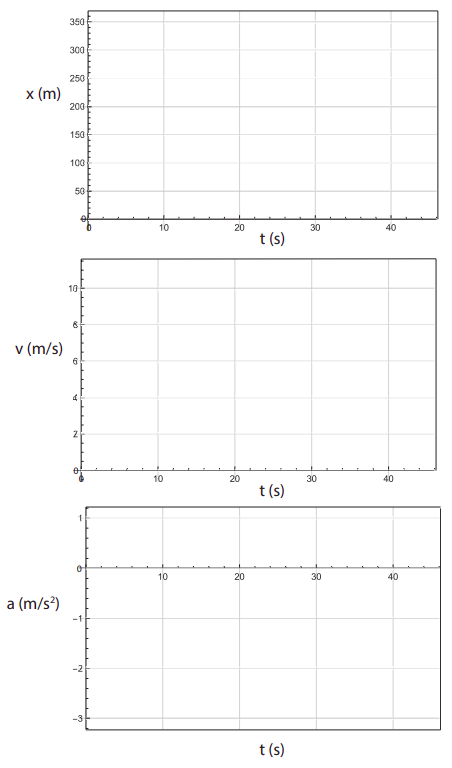2.6: Ejercicios
( \newcommand{\kernel}{\mathrm{null}\,}\)
Ejercicio2.6.1
Te subes a tu bicicleta y la montas con una aceleración constante de 0.5 m/s 2 durante 20 s. Después de eso, continúas circulando a velocidad constante por una distancia de 200 m. Finalmente, bajas a una parada, con una aceleración constante, sobre una distancia de 20 m.

- ¿Hasta dónde viajaste mientras acelerabas a 0.5 m/s 2, y cuál era tu velocidad al final de ese intervalo?
- Después de eso, ¿cuánto tiempo tardaste en cubrir los siguientes 200 m?
- ¿Cuál fue tu aceleración mientras bajabas la velocidad a una parada, y cuánto tiempo tardaste en llegar a un alto?
- Considerando todo el viaje, ¿cuál fue tu velocidad promedio?
- Trazar los gráficos de posición versus tiempo, velocidad versus tiempo y aceleración versus tiempo para todo el viaje, en las cuadrículas proporcionadas anteriormente. Los valores al principio y al final de cada intervalo deben ser exactos. Las pendientes y las curvaturas deben representarse con precisión. No dibujes ninguna de las curvas más allá del tiempo que el piloto se detiene (o, si lo haces, ¡asegúrate de que lo que dibujas tenga sentido!).
Ejercicio2.6.2
Tiras un objeto recto hacia arriba y lo vuelves a atrapar, cuando baja a la misma altura inicial, 2 s después.
- ¿Qué tan alto se elevó por encima de su altura inicial?
- ¿Con qué velocidad inicial la tiraste?
(Nota: para este problema se debe utilizar el hecho de que, si el arrastre de aire es insignificante, el objeto volverá a su altura inicial con la misma velocidad que tenía inicialmente.)
Ejercicio2.6.3
Estás tratando de alcanzar un auto que está frente a ti en la autopista. Inicialmente ambos se mueven a 25 m/s, y la distancia entre ustedes es de 100 m. pisa el acelerador y mantiene una aceleración constante por un tiempo\ (\ Delta t\) = 30 s, momento en el que ha tirado incluso con el otro automóvil.
- ¿Qué es 25 m/s, en millas por hora?
- ¿Cuál fue su aceleración en el intervalo de tiempo de 30 s?
- ¿Qué tan rápido ibas cuando alcanzaste el otro auto?
Ejercicio2.6.4
Regrese al Ejercicio 1.6.4 del Capítulo 1, y use la información de la figura para dibujar una gráfica precisa de posición vs. tiempo para ambos corredores.
Ejercicio2.6.5
Un niño en un trineo se desliza ( partiendo del descanso) por una pendiente helada que hace un ángulo de 15∘ con la horizontal. Después de deslizarse 20 m por la pendiente, la niña ingresa a una región plana y fangosa, donde se desliza durante 2.0 s con una aceleración negativa constante de −1.5 m/s 2 con respecto a su dirección de movimiento. Luego se desliza por otra pendiente helada que hace un∘ ángulo de 20 con la horizontal.
- ¿Qué tan rápido iba la niña cuando llegó al fondo de la primera pendiente? ¿Cuánto tiempo le tomó llegar ahí?
- ¿Cuánto tiempo fue el tramo plano en la parte inferior?
- ¿Qué tan rápido iba la niña cuando arrancaba la segunda pendiente?
- ¿A qué distancia se deslizó en la segunda pendiente?


